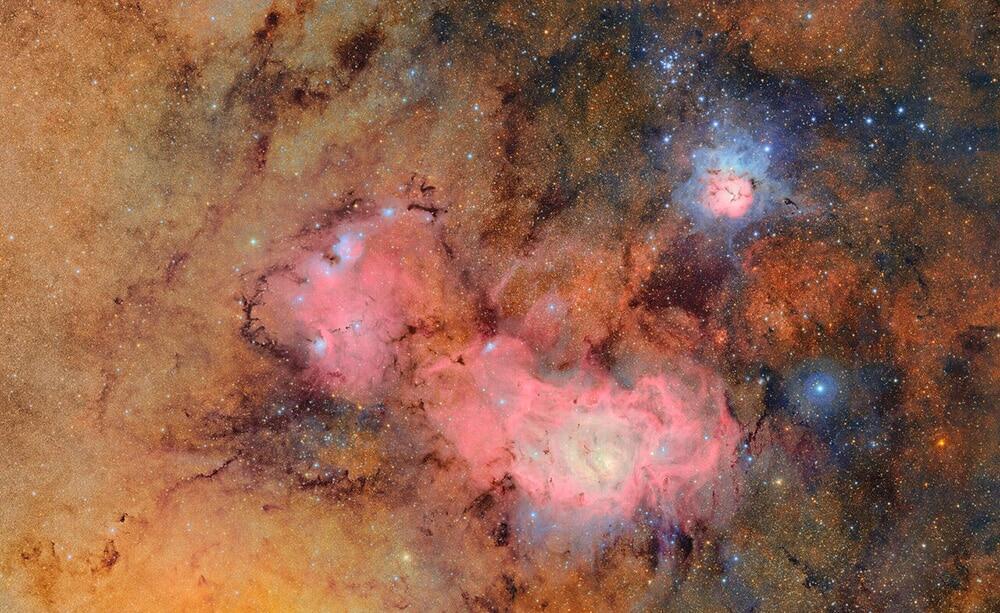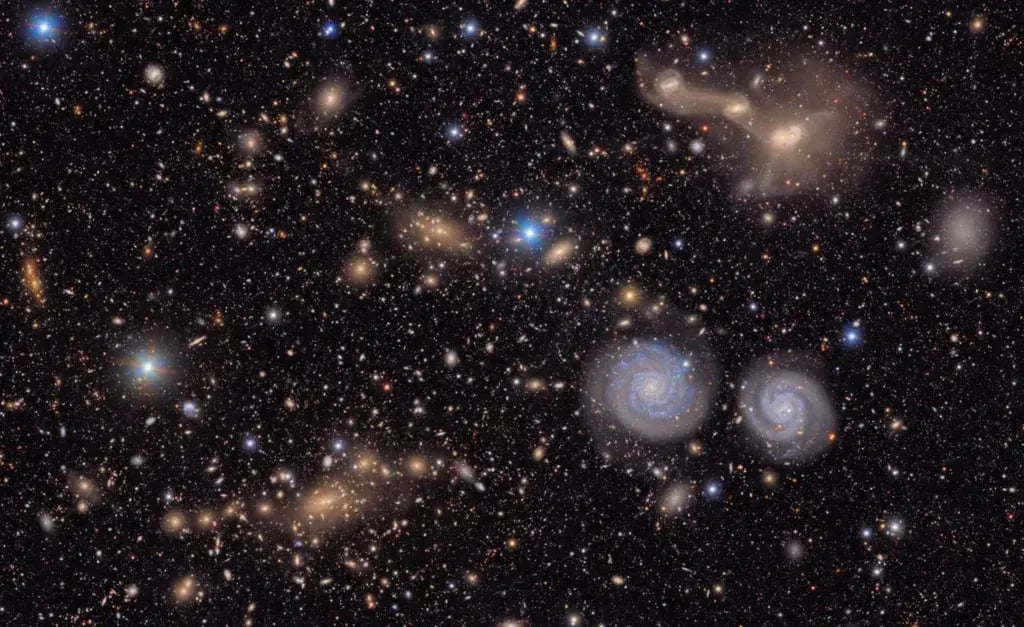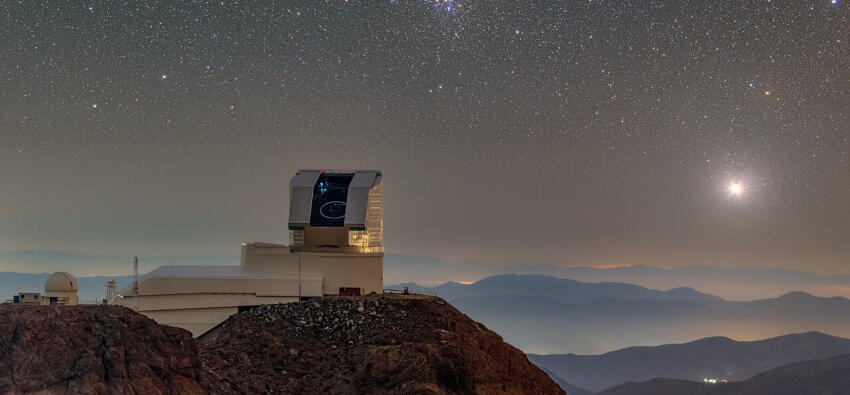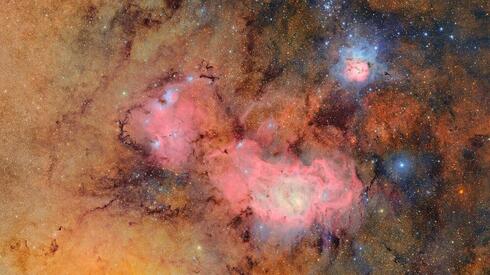The NSF–DOE Vera C. Rubin Observatory has released its first images, demonstrating its capabilities just two months after beginning trial operations. Built in Chile over nearly three decades at a cost of more than one billion dollars, the American observatory’s debut images showcase its exceptional imaging power.
The telescope features an exceptionally wide field of view — 3.5 degrees by 3.5 degrees — with each image covering a section of the sky approximately 45 times larger than the full Moon. It is designed to capture around 1,000 images per night, enabling a complete survey of the southern sky every three to four nights. This means each region of the sky will be imaged about 800 times over the course of the telescope’s planned 10 years of operation.
3 View gallery

Giant images with unprecedented detail. The Trifid Nebula and Lagoon Nebula, located several thousand light-years away, captured in a composite made from 678 exposures by the Vera C. Rubin Observatory
(Photo: RubinObs/NOIRLab/SLAC/NSF/DOE/AURA)
Unlike narrow-field telescopes, which are designed to zoom in on individual objects and examine them in detail, wide-field telescopes scan large areas of the sky. This broad view allows scientists to monitor changes and transient phenomena, discover previously unknown celestial objects, and, when needed, guide other telescopes to study them more closely.
The Rubin telescope is equipped with an 8.4-meter primary mirror — modest in comparison to upcoming next-generation ground-based telescopes like the Giant Magellan Telescope, which will feature a 25-meter mirror and is expected to begin operations in 2030. While not larger than many current operational telescopes, Vera Rubin’s great advantage lies in its extremely sophisticated camera, roughly the size of a small car and weighing about three tons. Each image it captures is 3,200 megapixels, making it the largest digital camera in the world.
The camera aboard the Rubin telescope uses six color filters, each isolating a narrow wavelength range — effectively capturing one color at a time. A sophisticated mechanical system allows the filters to be swapped within minutes, enabling near-simultaneous imaging of the same region of sky in several colors. Final images are composites of many individual exposures and contain enormous amounts of data.
Due to the size of its mirror, the telescope is not designed to focus on specific details such as a specific galaxy or solar system, unlike large ground-based telescopes or space telescopes like James Webb and Hubble. Instead, its strength lies in its wide-field, high-detail images, which are expected to allow for the identification of countless celestial objects and, as noted, enable the continuous monitoring of dynamic processes over time. In total, the telescope is expected to collect about 20 terabytes of data each night (that’s 20,000 gigabytes), and over the course of its operations, to accumulate approximately 500 petabytes (half a billion gigabytes) of information — comprising astronomical images and a detailed catalog of billions of stars, galaxies, and other celestial bodies.
3 View gallery


Billions of galaxies in one snap
(Photo: RubinObs/NOIRLab/SLAC/NSF/DOE/AURA/P. Horálek (Institute of Physics in Opava))
The telescope is expected to collect about 20 terabytes of data each night (20,000 gigabytes) and, over its 10-year operational lifetime, to accumulate roughly 500 petabytes (half a billion gigabytes) of astronomical images and detailed catalogs of billions of stars, galaxies, and other celestial bodies.
Researchers estimate that the Rubin telescope will identify more stars and planetary systems than any previous instrument, while also boosting planetary defense efforts through the detection of numerous asteroids — including some that may pose future threats to Earth. Even during its trial phase, the telescope identified more than 2,000 previously unknown asteroids in just ten hours of imaging. For comparison, the current global discovery rate is about 20,000 new asteroids per year.
“NSF-DOE Rubin Observatory will capture more information about our universe than all optical telescopes throughout history combined,” said Brian Stone, acting director of the U.S. National Science Foundation (NSF). “Through this remarkable scientific facility, we will explore many cosmic mysteries, including the dark matter and dark energy that permeate the universe.”
Even during its trial phase, the Vera C. Rubin Observatory identified more than 2,000 previously unknown asteroids. A video demonstration of the telescope’s detection capabilities.
The Vera C. Rubin Observatory is located at the summit Cerro Pachón in central Chile, at an elevation of nearly 2,700 meters (8,860 feet) above sea level. In recent decades, Chile has become the world’s hub for optical astronomy — thanks to a combination of geographic and human factors: high mountain peaks that allow observation above a portion of the atmosphere, dry air with minimal cloud cover, and remote locations free from light pollution.
3 View gallery


The NSF–DOE Vera C. Rubin Observatory in Chile
(Photo: RubinObs/NOIRLab/SLAC/NSF/DOE/AURA/P. Horálek (Institute of Physics in Opava))
Named after American astronomer Vera Rubin (1928–2016) — who made groundbreaking discoveries about the rotational speeds of galaxies and whose work laid the foundation for the dark matter theory — the idea of an invisible mass that explains galaxies’ unexpectedly rapid motion — the telescope is expected to significantly advance our understanding of the universe. Researchers also hope it will help unravel the mystery of dark energy, the force thought to drive the universe’s accelerated expansion, and shed light on other fundamental cosmic puzzles.
The telescope is jointly operated by scientists at the SLAC National Accelerator Laboratory (part of the U.S. Department of Energy) and NOIRLab, the U.S. National Science Foundation’s center for ground-based optical astronomy. It operates in collaboration with a broad network of international partners — including Israel, which will contribute through its ULTRASAT space telescope project, currently under development at the Weizmann Institute of Science and scheduled for launch in about two years. Like the Rubin telescope, ULTRASAT will feature a wide field of view and repeatedly scan the sky — but in ultraviolet rather than visible light, making the two telescopes complementary in many aspects. Under the collaboration agreement, American researchers will gain access to ULTRASAT’s data, while Israeli scientists will be able to use data from the Rubin telescope.
The immense amount of data expected to be produced by the observatory will add to a growing number of major sky-mapping initiatives in recent years, including the Milky Way maps produced by the European Space Agency’s Gaia space telescope, which recently completed its mission, and another sky survey by NOIRLab. Also joining this expanding list of sky surveys is LAST, an array of telescopes developed by the Weizmann Institute of Science, which recently began operating in southern Israel. Although LAST covers smaller areas of the sky than the Vera Rubin Telescope, it revisits each section multiple times per night to track rapidly changing phenomena — generating even more data than the new Rubin telescope is expected to produce. Each project has its own strengths and scientific goals, but together — and thanks to advances in computing and big data technologies now transforming astronomy — we are now collecting an unprecedented wealth of information about our universe.
The Rubin Telescope also supports an educational program that gives students and teachers access to its data and images for learning and research. “The Vera Rubin Telescope is an investment in our future,” said Michael Kratsios, then-Director of the White House Office of Science and Technology Policy. “It will lay down a cornerstone of knowledge today on which our children will proudly build tomorrow.”
